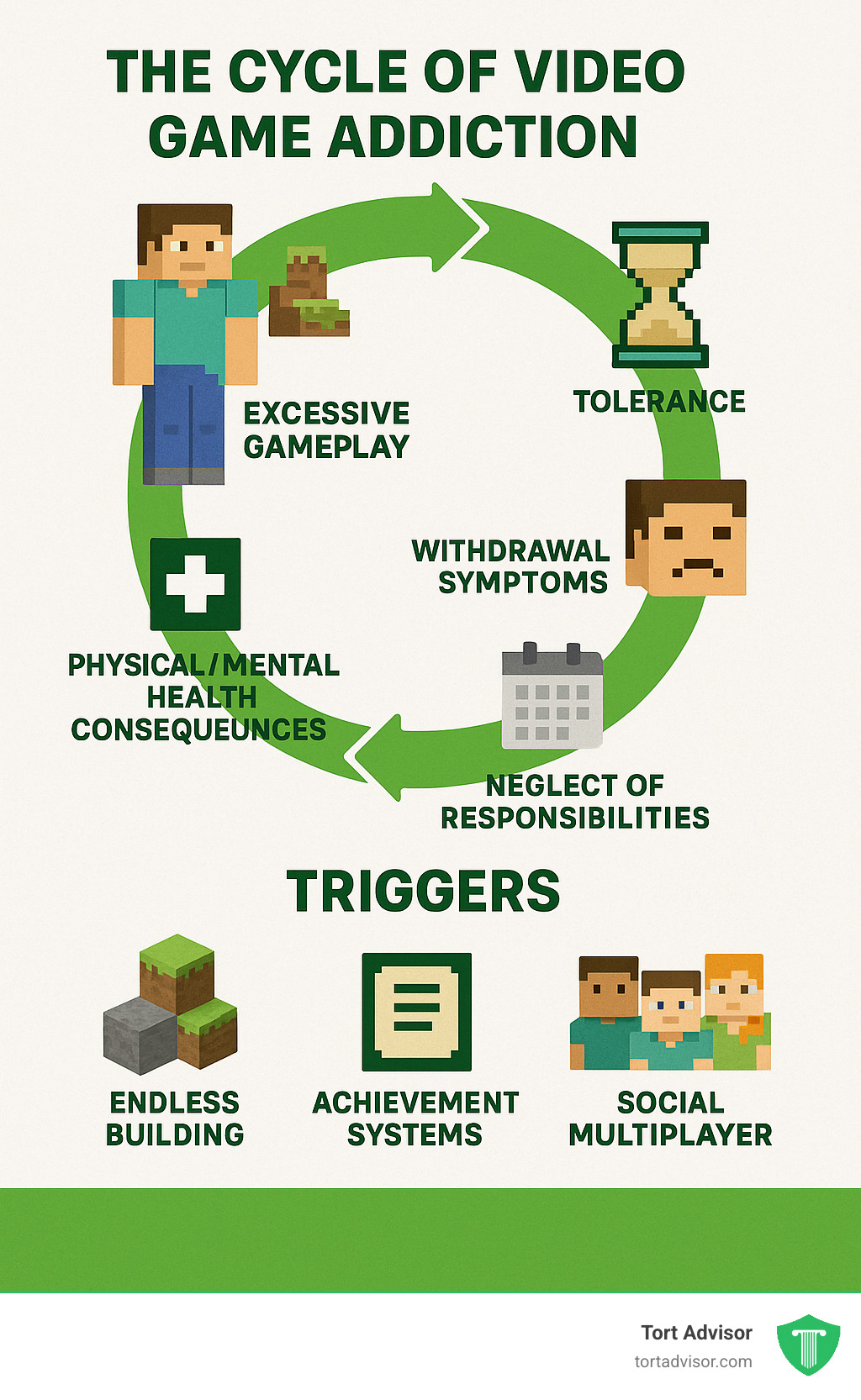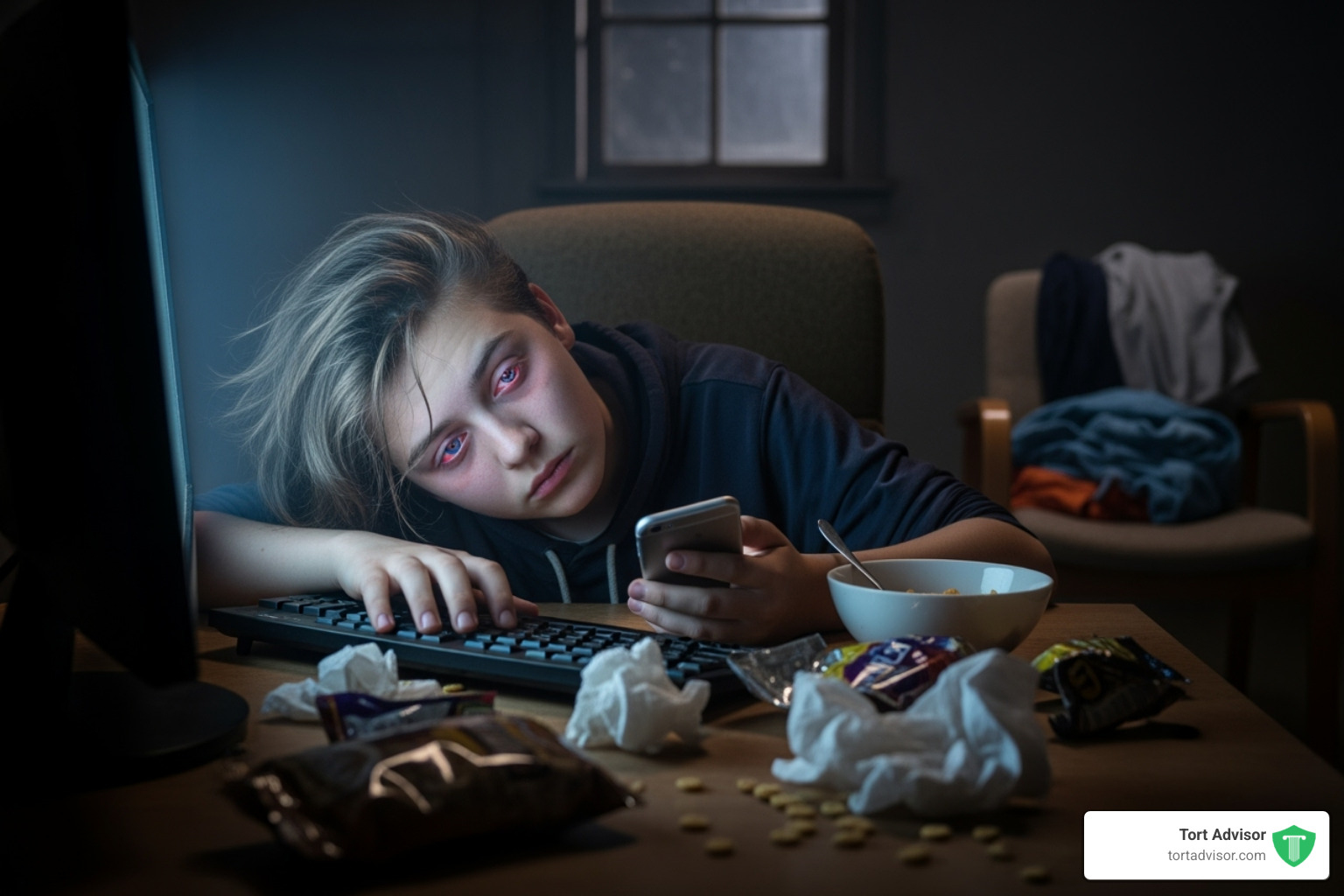


The Growing Legal Battle Over Gaming Addiction
The minecraft class action lawsuit is a major legal challenge against one of the world’s most popular video games. Families claim the game was intentionally designed to be addictive and harmful, especially to children.
Key Facts About the Minecraft Class Action Lawsuit:
- Primary Defendants: Mojang Studios (developer) and Microsoft Corporation (owner)
- Main Allegations: Intentional addictive design, failure to warn of addiction risks, targeting vulnerable populations
- Legal Claims: Product liability, negligence, fraud, consumer protection violations
- Affected Population: Primarily children and adolescents, with a focus on neurodivergent minors
- Health Consequences: Depression, anxiety, social isolation, physical injuries, academic decline
- Current Status: Consolidated in California state court (JCCP No. 5363), federal MDL request denied
- Potential Damages: Estimated $25,000-$350,000+ depending on the severity of harm
The lawsuit alleges Minecraft’s open-ended gameplay, reward systems, and lack of natural stopping points create psychological dependency. Plaintiffs claim that over 23% of children play Minecraft more than 11 hours a week, leading to what experts call Internet Gaming Disorder.
For example, one key lawsuit filed by California mother Jennifer Sawyer claims her child developed a compulsive gaming habit at age 6, leading to social isolation and withdrawal. Her case is one of hundreds nationwide.
The legal arguments mirror successful cases against tobacco and opioid companies, focusing on how corporations allegedly prioritize profits over public health. While gaming companies cite First Amendment protections, courts have historically ruled against corporations when their products cause documented harm.
Minecraft class action lawsuit basics:
What Are the Allegations in the Minecraft Lawsuit?
The minecraft class action lawsuit levels serious accusations against Mojang Studios, the game’s developer, and Microsoft Corporation, which acquired Mojang for $2.5 billion in 2014. The core claims allege an intentional corporate strategy to hook players, including intentional addictive design, failure to warn users about addiction risks, negligence in protecting vulnerable players, and fraud in how the game was marketed.
This legal battle is part of a broader industry reckoning, with similar lawsuits targeting Epic Games (Fortnite) and Roblox. The legal strategies echo successful cases against tobacco and opioid companies, which were held accountable for prioritizing profits over public health despite knowing their products caused harm. For more information about this type of case, you can explore how these legal battles unfold.
How Minecraft is Allegedly Designed for Addiction
The lawsuit details how Minecraft allegedly uses carefully crafted psychological mechanisms to hook players.
- Endless Gameplay: At the core of the allegations is the game’s open-ended gameplay. Unlike games with clear endings, Minecraft offers infinite worlds with no natural stopping points, encouraging players to continue indefinitely.
- Reward Systems: The game’s rewarding progression systems—from mining diamonds to building structures—provide a steady stream of rewards that trigger dopamine release in the brain. This creates a positive feedback loop that reinforces continuous play.
- Psychological Triggers: Deliberate design choices, such as satisfying sounds and the visual sparkle of rare items, are used as psychological triggers to make the game feel rewarding on a neurological level.
- Gambling-like Mechanics: Variable reward schedules, similar to slot machines, mean players never know when they’ll find a rare item. This unpredictability keeps them engaged and constantly anticipating the next reward.
- Social Pressure: Multiplayer modes add social pressure, as players feel obligated to join friends online, driven by a fear of missing out. In-game purchases through the marketplace create additional hooks for continued engagement and spending.
Research on how game structure fosters addiction supports claims that these design elements can create compulsive behaviors, especially in vulnerable individuals.
The Primary Legal Arguments Against Game Developers
The lawsuit is built on established legal principles like product liability and consumer protection.
- Design Defect: The primary argument is that Minecraft has a design defect. Not a technical bug, but an intentional design crafted to be addictive and therefore “unreasonably dangerous.”
- Failure to Warn: Plaintiffs argue that Mojang and Microsoft had a duty to warn consumers about the foreseeable risks of addiction but failed to do so.
- Consumer Protection Violations: By marketing Minecraft as harmless family fun while allegedly knowing it could cause psychological harm, the companies may have engaged in deceptive business practices.
- Targeting Vulnerable Populations: The lawsuits emphasize that the game’s design exploits the cognitive vulnerabilities of children and adolescents, whose brains are still developing. This is especially true for neurodivergent minors with conditions like ADHD or autism, who may struggle more with impulse control. Courts are often more protective when vulnerable populations are targeted.
For more on how these large-scale legal actions work, you can learn about mass tort cases.
The Reported Health Consequences of Excessive Gameplay
The minecraft class action lawsuit highlights the severe health consequences of excessive gaming. Both the American Psychiatric Association and the World Health Organization now recognize Internet Gaming Disorder (IGD) as a mental health condition characterized by gaming behavior that takes priority over other life interests.
The problem is particularly acute for children and teens, as their developing brains are more vulnerable to the reward systems in games like Minecraft. Areas responsible for impulse control and emotional regulation are still forming, making it harder for young players to stop. For more context, see scientific research on the health effects of too much gaming.
Mental and Emotional Health Effects
The mental toll described in lawsuit cases is often heartbreaking. Families report serious psychological challenges, including:
- Depression and Anxiety: These conditions can develop as players get trapped in a cycle of gaming for temporary relief, which worsens their real-world problems.
- Social Isolation: Excessive gaming often crowds out friendships and family relationships, leading to withdrawal and loneliness.
- Irritability and Anger: So-called “gamer’s rage” can erupt when gaming is interrupted, sometimes leading to threats or behavior that is out of character.
- Academic and Work Decline: As gaming becomes the priority, responsibilities suffer, with some students dropping out of school entirely.
Excessive gaming can also prevent the development of healthy coping mechanisms, making real-world challenges seem impossible. Studies on gaming and mental health show a correlation between excessive play and increased rates of depression, anxiety, and even suicidal ideation.
Physical Health Toll of Gaming Addiction
The physical consequences of gaming addiction can be just as serious as the mental health impacts.
- Sleep Disorders: Late-night gaming and screen stimulation disrupt natural sleep cycles, sometimes leading to severe sleep deprivation.
- Musculoskeletal Issues: Hours spent in poor posture can cause chronic back, neck, and shoulder pain. Repetitive strain injuries like Carpal Tunnel Syndrome and “Gamer’s thumb” are also common.
- Eye Strain: Staring at screens for extended periods leads to Computer Vision Syndrome, causing dry eyes, blurred vision, and headaches.
- Weight Gain: A sedentary lifestyle combined with poor eating habits often results in significant weight gain and related health problems.
These physical issues can compound mental health challenges, making it even harder to break free from addiction. Studies on physical health issues from gaming provide further insight into these patterns.
Navigating the Legal Battle: A Guide to the Minecraft Class Action Lawsuit
Understanding the legal side of the minecraft class action lawsuit can be intimidating. We’re here to help you make sense of it all. While often called a “class action,” these cases are proceeding differently. Courts denied a request to bundle them into one federal lawsuit (an MDL), so individual cases are moving forward in state courts, which can be advantageous due to stronger local consumer protection laws.
In California, many lawsuits have been grouped into Judicial Council Coordinated Proceeding (JCCP) No. 5363. This streamlines the process by ensuring consistent rulings across similar cases. Our goal is to provide the knowledge you need to make informed decisions about your legal options.
Current Status and Timeline of the Minecraft Class Action Lawsuit
The legal fight against gaming companies is ongoing. With the denial of a federal MDL, lawsuits are proceeding in various state courts, most notably in California’s JCCP No. 5363. This coordinated proceeding allows lawyers to share resources and helps move cases through the system efficiently.
Gaming companies like Microsoft, Activision Blizzard, Roblox, and Nintendo have filed motions to dismiss these lawsuits, primarily arguing a First Amendment defense that video games are protected artistic expression. However, this argument has failed in the past for other industries, like tobacco and opioids, when products were shown to be deliberately designed to be addictive and harmful. The momentum for accountability is building, and the legal landscape appears to be shifting in favor of consumer protection.
Evidence and Damages in a Minecraft Class Action Lawsuit
Building a strong case requires evidence connecting excessive gaming to the harm suffered. Key evidence includes:
- Medical Documentation: Records from doctors or therapists diagnosing Internet Gaming Disorder or related conditions like depression and anxiety.
- Gaming Activity Logs: Screenshots or game data showing the amount of time spent playing Minecraft.
- Financial Records: Bank or credit card statements showing spending on in-game purchases or microtransactions.
- School or Employment Records: Report cards, attendance issues, or performance reviews documenting a decline in real-world functioning.
- Witness and Expert Testimony: Statements from family, friends, or teachers, along with testimony from addiction specialists.
Compensation sought covers the full spectrum of harm, including medical expenses, emotional distress, financial losses (in-game purchases, lost wages), and loss of quality of life. While no Minecraft-specific settlements exist, experts estimate potential payouts based on similar cases. Milder cases might see settlements from $25,000 to $90,000, while severe cases could result in $100,000 to $350,000 or more. For more information, you can explore how much mass tort lawsuits can receive.
How to Determine if You Qualify for a Lawsuit
To determine if your family’s situation qualifies for legal action, consider the following criteria:
- Age: The player is typically 24 years old or younger when the addiction and harm occurred, as minors are considered more vulnerable.
- Playtime: There is documented evidence of excessive and prolonged gameplay, such as at least 2-3 hours per day for several weeks.
- Diagnosis: A medical or psychological diagnosis of Internet Gaming Disorder (IGD) or a related condition (e.g., severe depression, gamer’s rage) is crucial.
- Treatment: The individual has sought or received professional treatment for the addiction, demonstrating its severity.
- Harm: There is clear evidence of financial, physical, mental, or academic/occupational harm directly linked to the gaming addiction.
If your situation includes these elements, we encourage you to reach out for a free consultation to review your eligibility and discuss the path forward.
Frequently Asked Questions about the Minecraft Lawsuit
Navigating video game addiction lawsuits can be overwhelming. Here are answers to the most common questions about the minecraft class action lawsuit to help you understand your options.
Who are the main defendants in these lawsuits?
The primary defendants are Mojang Studios, the original developer of Minecraft, and its parent company, Microsoft Corporation, which acquired Mojang in 2014. Lawsuits name both companies, holding Mojang responsible for the game’s allegedly addictive design and Microsoft for marketing and distributing it without adequate warnings about addiction risks. This strategy ensures the entire corporate structure is held accountable.
What kind of compensation can plaintiffs expect?
Plaintiffs seek compensation for damages caused by gaming addiction, including medical and therapy costs, reimbursement for in-game purchases, and damages for emotional distress and loss of quality of life. While no settlements have been reached, legal experts estimate potential payouts based on the severity of harm. Milder cases might range from $25,000 to $90,000, while moderate cases with significant life disruption could see $100,000 to $350,000. The most severe cases, involving permanent injuries or total disruption of life prospects, could result in compensation of $2 million or more.
Can I file a lawsuit on behalf of my minor child?
Yes. Parents and legal guardians can and often must file lawsuits on behalf of their minor children. The legal system allows a parent to act as a “next friend” or legal guardian to protect the child’s interests and seek compensation for the harm they have suffered. The parent is the plaintiff, but the case is centered on the harm to the child.
Experienced attorneys handle these sensitive family situations with compassion, understanding that addiction impacts the entire family. The legal process is designed to protect the child’s interests, often requiring court approval for settlements to ensure the compensation benefits the minor’s long-term well-being.
How to Move Forward with a Video Game Addiction Claim
The rise in lawsuits against gaming giants like Microsoft shows a growing recognition that video games can cause real harm when designed to be addictive. These legal challenges aim to hold companies accountable for prioritizing profits over the well-being of vulnerable players, particularly children.
If you or a loved one has suffered from severe gaming addiction, you may have legal options. The minecraft class action lawsuit and similar cases are paving the way for families to seek justice. The law recognizes that when companies design products to be addictive, they have a responsibility to warn consumers and ensure those products are safe.
At Tort Advisor, we specialize in connecting families with top-rated specialty attorneys with proven experience in video game addiction cases. We partner exclusively with highly skilled attorneys with proven results to ensure you have the best possible representation.
Your journey toward accountability starts with a free, no-obligation consultation. Our network of attorneys can help you determine if you qualify for a lawsuit, gather evidence, and steer the complex legal process. They will fight for the compensation you deserve for medical expenses, emotional distress, and lost quality of life.
To take the first step toward justice and healing, find out more about the Video Game Addiction Lawsuit and how we can help.
Free Confidential Case Evaluation
Complete the short form below to get an immediate FREE case review with an expert in your specific claim. Don't wait, your case could be time sensitive to file a claim.
Related Posts
Did a North Dakota product cause harm? Understand product liability, your rights, and how to take action for defects.
Get justice for clergy abuse. Find an expert Priest abuse lawyer to navigate complex laws and hold institutions accountable.
Diagnosed with meningioma after Depo-Provera? Understand potential Depo-Provera lawsuit settlements, risks, & how to claim compensation.
Uncover the truth about uber sexual assault cases. Learn about the alarming scale, Uber's accountability, and legal options for justice.
Facing wildfire losses? Discover the best wildfire lawsuit attorneys in California to fight for your full recovery and justice.
Exposed to Roundup & diagnosed with NHL? Discover how to sue Monsanto, understand eligibility, & seek compensation. Your guide to justice.








